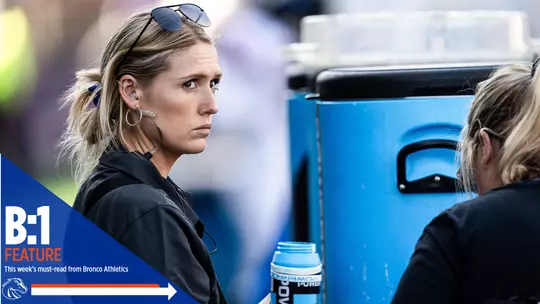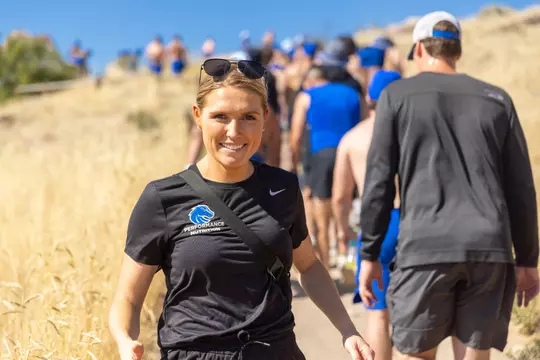
Fueling the Broncos
Alex Semadeni
Every season during fall camp, Boise State Football undergoes an Inferno Day. During Inferno Day, the team practices inside the Caven-Williams Indoor Facility where the heat is cranked up to the max. The idea is to simulate above-average temperatures that the team is likely to experience early in the season.
This season, in preparation for their season-opener on the road in the Georgia heat and humidity, the Broncos partook in two Inferno Days during fall camp. Those specific practices however weren’t just for the players and coaches – it helped the support staff as well.
For assistant athletic director of performance nutrition Sam Wade, those two practices were extremely important. She spent the scorching three-hour practices observing how individual players were reacting to the heat.
“I was really happy for the Inferno Days and that I could be at practice for those days,” Wade said. “The data we got is so important. I got to see how each player responds under those conditions and adjust from there. That’s where a lot of my focus went.”
As part of her job, Wade collected a variety of data points from the two practices. Most important of the data sets was how much hydration a player would lose. With that information, Wade could prepare specific game plans for each athlete from a nutrition standpoint, and be prepared on the sidelines with the necessary solutions.
“We wanted to know how much hydration the players were losing by tracking the percent change in body weight from before and after practice,” Wade said. “Understanding who are the heavy sweaters, the salty sweaters, who’s more likely to cramp – it’s all extremely valuable. I could go into Georgia Southern knowing how each individual responds.”
As the date of the season-opener crept closer, so too did the noise about the severity of the heat in Georgia. But Wade was prepared.
“I felt like I could make a huge impact on the outcome of that game,” Wade said. “That kind of environment could be a significant issue if unprepared. Therefore, I knew I needed to take advantage of those Inferno Days to set the team up for success from a hydration standpoint. Spending time studying the team and working with the players individually to come up with a plan, gave both the players and myself confidence going into the weekend."
Wade’s impact on the program showcases a recent push to incorporate healthy nutritional habits into the daily routine in the Bleymaier Football Center.
The former Penn State softball player first started working for the program in September 2021. With football already in full swing, she spent a majority of her time developing the nutrition department to make sure it was utilized properly among all Bronco sport programs.

Joining the staff midway through the football season, Wade primarily observed the football operations and looked for opportunities where she could make an impact. She noticed two areas where she thought she could quickly make some effective changes – road trip food menus and post-practice food options.
“I started helping with choosing some items to order from Albertsons to have stocked in the fueling station,” Wade said. “One of the things that I noticed: it was the same thing every week. Everyone was getting really tired of the same meals because they were getting it all the time. That taste fatigue always hit. I figured that was something that I could help with.”
Another change that Wade insisted on was eating meals directly after practice. Currently, the team has a rule where each member of the team must drink a protein shake and eat a meal within 45 minutes after each practice or lift.
“One of the reasons we do it that way is to optimize the timing of nutrients for the best recovery possible," Wade said. “For any athlete, eating carbohydrates and protein within 45 minutes post-exercise is going to promote better muscle repair and recovery in comparison to waiting a couple of hours to eat. We try to time it so that they are optimizing their nutrition.”
Her department continued to expand, with a second full-time dietitian Jamie Pepper, joining the athletic department in the summer of 2023. The addition of Pepper allowed Wade to transition into a position that would work solely with the football program. She continued to make positive changes within the program, and under her guidance, the nutrition department started to take on more significance.
“Over time, we took on more and more responsibilities, like completing body composition tests and blood work analysis," Wade said. “Each year our team started to grow with more staff and student-interns. Naturally, it grew to the point that we were overseeing and managing a lot more than just menu advising. Ultimately allowing the nutrition team to give better care and support to our student-athletes.”
Wade’s first office at Boise State was located in the Varsity Center, on the south side of Albertsons Stadium. When she moved across The Blue to Bleymaier, her office was strategically positioned inside the athletic training room, giving her ample opportunity to communicate with both the athletic training staff and the strength and conditioning staff. That communication comes in handy in regards to both preparation and recovery plans.
“It works out really well because our areas are so connected,” Wade said. “It's a collaboration of all of us working together, along with our team physicians. When our areas are united, we are able to make an even greater impact on the health and performance of student-athletes.”
It also allows Wade the opportunity to get to know the student-athletes.

“Guys will be sitting on the training tables and it’s an easy check-in opportunity,” Wade said. “Instead of scheduling a meeting and having them walk over to the Varsity Center, we can have a three-minute conversation where I provide bite-sized nutrition education more frequently. I'm able to form a stronger connection with the student-athletes. When the players apply the information and find success, it promotes greater trust and grows the value of the nutrition team."
That connection also coincided with Wade’s goal of program-wide communication. As her staff continued to expand, she began developing education presentations to give to not only the athletes, but the staff as well.
The primary goals of her presentations are centered around a few basic areas: staying properly hydrated, optimizing timing of nutrition and eating well-balanced meals.
Wade also created an easy-to-remember moniker for student-athletes to remember when deciding what to put on their plate for a meal. The phrase – PCC, which stands for proteins, carbs and color – has become oft-repeated in the football building.
“If you have PCC on your plate and are carb-matching your plate to the amount of exercise you do that day, you're doing better than a lot of people at every meal," Wade said. “To make things simple, a sound nutrition plan is being consistent with the foundations.”
Wade and her team aren’t only teaching the basics. They’re reinforcing the benefits, using some of their data collection to demonstrate to the athletes what a good diet and staying hydrated can do.
One example of this is through hydration testing. Two days before competition, each player will get their hydration levels tested. Those results come out as a number, with each number falling into a particular target range. Ideally, a student-athlete will land between 50-199 – the green range.
“The higher the number, the less hydrated they are,” said graduate assistant and former Bronco beach volleyball student-athlete Joey Benson. “The lower the number, the more hydrated they are. We give them a color and a number of what their hydration score is. We want them to be improving on it during the season. It’s kind of fun. They compete with it a little bit. It’s good to have a little friendly competition with it.”
If a player has a higher number (meaning the player is trending towards dehydration), the nutrition team, strength and conditioning team and the athletic training staff develop a plan to make sure that player is ready to go before competition.
Hydration, and nutrition for that matter, can be especially difficult to maintain on road trips. Wade is an important member of the travel party, as she is responsible for properly hydrating and providing food options for the team over multiple meals. Wade prefers the team eat a meal every three to four hours, which can sometimes be difficult to maintain with varying kickoff times.
The football program has realized the value of hydration, mainly because it’s easy to see the results. As the testing has become more routine, the players have an easier time identifying the correlation between their hydration scores and susceptibility to injury.
Hydration, and nutrition for that matter, can be especially difficult to maintain on road trips. Wade is an important member of the travel party, as she is responsible for properly hydrating and providing food options for the team over multiple meals. Wade prefers the team eat a meal every three to four hours, which can sometimes be difficult to maintain with varying kickoff times.

Wade’s Inferno Day preparation comes into play on gamedays. From the time the team arrives on the field to the ending kickoff, Wade, who is loaded up with a go-pack of instant food options, is constantly monitoring athletes to see if they need instant fuel.
“I watch maybe two minutes of the game when I’m on the sideline,” Wade said. “Game time is go-mode. I don’t really have a chance to watch the games. It’s my responsibility to know that about every player. If I know that after the second quarter that someone is going to be more likely to cramp, I have to be ready so that I can mitigate the chances of that happening.”
Immediately following the contest, Wade will have protein shakes ready to hand out to the team as they are heading back into the locker room. When each player leaves the locker room, a postgame meal is already set up so the team can eat on the bus. As the plane is loaded to head back home, players can grab snacks from a table that has been laid out prior to boarding.
The commitment to nutrition wouldn’t be possible without the buy-in from both the coaching staff and the players.
“Both the coaches and the team have learned a lot from our PowerPoint slides,” Benson said. “They ask a ton of questions and you can see that they’re being conscious and trying to learn. Everyone is having conversations about it. I think it’s beginning to click how it’s all intertwined. We’re making sure that everyone is healthy and able to play. I’ve seen a change from the players trying to eat well.”
Which all feeds into Wade’s overall mission. Her goal is to create a competitive advantage, but she also wants to build healthy habits, habits that can be utilized for years after the player is done participating on the field.
“My objective is for everyone to have a healthy relationship with food in their body,” Wade said. “I want them to understand that food can be such a value to them and make a big impact on their life. That’s my overall goal. I think there are so many mixed messages out there when it comes to nutrition and it can be really confusing. My goal is to make it simple, easy and something unique to them that they can carry on for life.”
